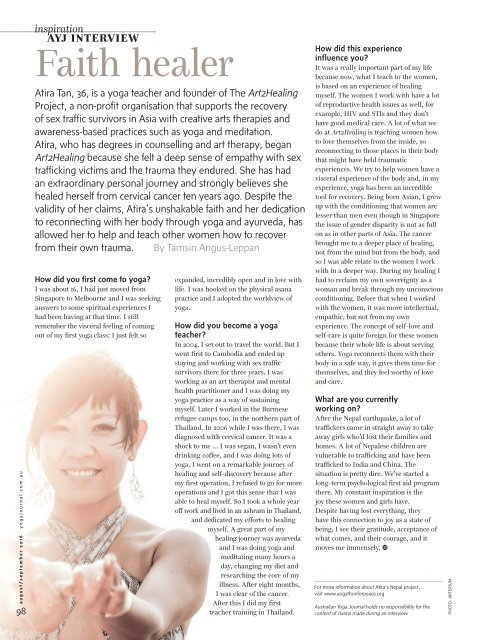Australian_Yoga_Journal_2016_08_09_downmagaz.com
You also want an ePaper? Increase the reach of your titles
YUMPU automatically turns print PDFs into web optimized ePapers that Google loves.
august/september <strong>2016</strong> yogajournal.<strong>com</strong>.au<br />
98<br />
inspiration<br />
AYJ INTERVIEW<br />
Faith healer<br />
Atira Tan, 36, is a yoga teacher and founder of The Art2Healing<br />
Project, a non-profit organisation that supports the recovery<br />
of sex traffic survivors in Asia with creative arts therapies and<br />
awareness-based practices such as yoga and meditation.<br />
Atira, who has degrees in counselling and art therapy, began<br />
Art2Healing because she felt a deep sense of empathy with sex<br />
trafficking victims and the trauma they endured. She has had<br />
an extraordinary personal journey and strongly believes she<br />
healed herself from cervical cancer ten years ago. Despite the<br />
validity of her claims, Atira’s unshakable faith and her dedication<br />
to reconnecting with her body through yoga and ayurveda, has<br />
allowed her to help and teach other women how to recover<br />
from their own trauma. By Tamsin Angus-Leppan<br />
How did you first <strong>com</strong>e to yoga?<br />
I was about 16, I had just moved from<br />
Singapore to Melbourne and I was seeking<br />
answers to some spiritual experiences I<br />
had been having at that time. I still<br />
remember the visceral feeling of <strong>com</strong>ing<br />
out of my first yoga class; I just felt so<br />
expanded, incredibly open and in love with<br />
life. I was hooked on the physical asana<br />
practice and I adopted the worldview of<br />
yoga.<br />
How did you be<strong>com</strong>e a yoga<br />
teacher?<br />
In 2004, I set out to travel the world. But I<br />
went first to Cambodia and ended up<br />
staying and working with sex traffic<br />
survivors there for three years. I was<br />
working as an art therapist and mental<br />
health practitioner and I was doing my<br />
yoga practice as a way of sustaining<br />
myself. Later I worked in the Burmese<br />
refugee camps too, in the northern part of<br />
Thailand. In 2006 while I was there, I was<br />
diagnosed with cervical cancer. It was a<br />
shock to me … I was vegan, I wasn’t even<br />
drinking coffee, and I was doing lots of<br />
yoga. I went on a remarkable journey of<br />
healing and self-discovery because after<br />
my first operation, I refused to go for more<br />
operations and I got this sense that I was<br />
able to heal myself. So I took a whole year<br />
off work and lived in an ashram in Thailand,<br />
and dedicated my efforts to healing<br />
myself. A great part of my<br />
healing journey was ayurveda<br />
and I was doing yoga and<br />
meditating many hours a<br />
day, changing my diet and<br />
researching the core of my<br />
illness. After eight months,<br />
I was clear of the cancer.<br />
After this I did my first<br />
teacher training in Thailand.<br />
How did this experience<br />
influence you?<br />
It was a really important part of my life<br />
because now, what I teach to the women,<br />
is based on an experience of healing<br />
myself. The women I work with have a lot<br />
of reproductive health issues as well, for<br />
example, HIV and STIs and they don’t<br />
have good medical care. A lot of what we<br />
do at Art2Healing is teaching women how<br />
to love themselves from the inside, so<br />
reconnecting to those places in their body<br />
that might have held traumatic<br />
experiences. We try to help women have a<br />
visceral experience of the body and, in my<br />
experience, yoga has been an incredible<br />
tool for recovery. Being born Asian, I grew<br />
up with the conditioning that women are<br />
lesser than men even though in Singapore<br />
the issue of gender disparity is not as full<br />
on as in other parts of Asia. The cancer<br />
brought me to a deeper place of healing,<br />
not from the mind but from the body, and<br />
so I was able relate to the women I work<br />
with in a deeper way. During my healing I<br />
had to reclaim my own sovereignty as a<br />
woman and break through my unconscious<br />
conditioning. Before that when I worked<br />
with the women, it was more intellectual,<br />
empathic, but not from my own<br />
experience. The concept of self-love and<br />
self-care is quite foreign for these women<br />
because their whole life is about serving<br />
others. <strong>Yoga</strong> reconnects them with their<br />
body in a safe way, it gives them time for<br />
themselves, and they feel worthy of love<br />
and care.<br />
What are you currently<br />
working on?<br />
After the Nepal earthquake, a lot of<br />
traffickers came in straight away to take<br />
away girls who’d lost their families and<br />
homes. A lot of Nepalese children are<br />
vulnerable to trafficking and have been<br />
trafficked to India and China. The<br />
situation is pretty dire. We’ve started a<br />
long-term psychological first aid program<br />
there. My constant inspiration is the<br />
joy these women and girls have.<br />
Despite having lost everything, they<br />
have this connection to joy as a state of<br />
being. I see their gratitude, acceptance of<br />
what <strong>com</strong>es, and their courage, and it<br />
moves me immensely.<br />
For more information about Atira’s Nepal project,<br />
visit www.yogathonforpeace.org<br />
<strong>Australian</strong> <strong>Yoga</strong> <strong>Journal</strong> holds no responsibility for the<br />
content of claims made during an interview.<br />
PHOTO: ARTERIUM


